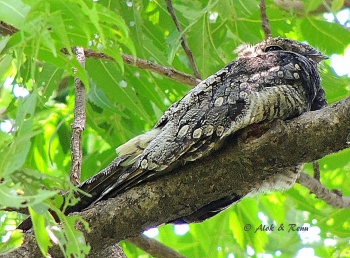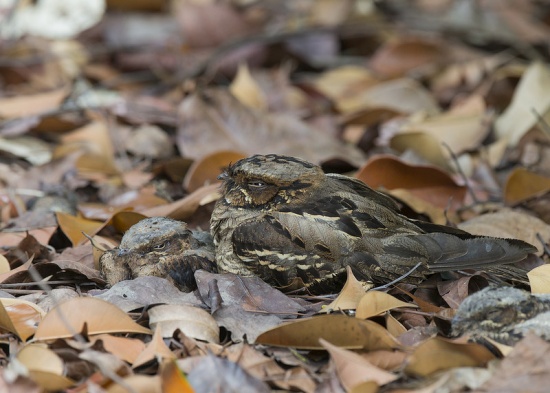(→External Links: Additional GSearch for common name. Video link deleted as no longer available. GSearch checked template) |
|||
| (18 intermediate revisions by 8 users not shown) | |||
| Line 1: | Line 1: | ||
| − | '' | + | [[Image:27381561067 2b605f4a24 c.jpg|thumb|550px|right|At roost with two youngsters, Subspecies ''C. m. bimaculatus''<br />Photo © by {{user|SeeToh|SeeToh}}<br />Singapore Botanic Gardens, [[Singapore]], May 2018]] |
;[[:Category:Caprimulgus|Caprimulgus]] macrurus | ;[[:Category:Caprimulgus|Caprimulgus]] macrurus | ||
| − | |||
==Identification== | ==Identification== | ||
| − | + | 25–29 cm (9¾-11½ in) | |
| − | + | *Greyish-brown upperparts, with blackish-brown streaks | |
| + | <br /> | ||
| + | Sexually dimorphic | ||
==Distribution== | ==Distribution== | ||
| + | [[Image:large-tailed_nightjar_alok.JPG|thumb|350px|right|Day-time perch on a high bough, subspecies ''C. m. albonotatus''<br />Photo © by {{user|aloktewari|Alok Tewari}}<br />[[Keoladeo National Park]], Bharatpur, Rajasthan, [[India]], September-2012]] | ||
Southern [[Asia]], northeast [[Pakistan]], East Indies to northern and eastern [[Australia]]. | Southern [[Asia]], northeast [[Pakistan]], East Indies to northern and eastern [[Australia]]. | ||
| − | |||
==Taxonomy== | ==Taxonomy== | ||
| − | '' | + | [[Andaman Nightjar]] ''C. andamanicus'' has been split from ''C. macrurus'' (Sangster & Rozendaal, 2004; Clements, 2007; Gill & Wright, 2008). |
| + | ====Subspecies==== | ||
| + | There are 6 subspecies<sup>[[#References|[1]]]</sup>: | ||
| + | *''C. m. albonotatus'': | ||
| + | :*North East [[Pakistan]] and northern [[India]] to [[Bhutan]] and [[Bangladesh]] | ||
| + | *''C. m. bimaculatus'': | ||
| + | :*North East India to southern [[China]], [[Sumatra]] and Riau Archipelago | ||
| + | *''C. m. johnsoni'': | ||
| + | :*South [[Philippines]] (Palawan, Busuanga and Culion) | ||
| + | *''C. m. salvadorii'': | ||
| + | :*North [[Borneo]], Labuan, Balambangan, Banguey and southern Sula islands | ||
| + | *''C. m. macrurus '': | ||
| + | :*[[Java]] and [[Bali]] | ||
| + | *''C. m. schlegelii'': | ||
| + | :*Wallacea, [[New Guinea]], New Britain and coastal northern [[Australia]] | ||
| − | |||
==Habitat== | ==Habitat== | ||
| − | + | They use a variety of habitats, showing a preference for areas with trees, mostly deciduous woodland and bamboo. | |
| − | |||
==Behaviour== | ==Behaviour== | ||
| − | Diet | + | ====Diet==== |
| − | + | Their diet consists almost entirely of flying insects, such as moths, crickets, wasps and grasshoppers. | |
| − | An unlined nest is made on ground | + | ====Breeding==== |
| + | An unlined nest is made on ground. Their clutch contains 2 pale cream eggs, with brown spots. Incubation by female lasts 21–22 days; fledging period is about three weeks. | ||
==References== | ==References== | ||
| − | Sangster, G. and Rozendaal, F. G. (2004) Systematics on Asian birds, 41. Territorial songs and species-level taxonomy of nightjars of the ''Caprimulgus macrurus'' complex, with description of a new species. Zool. Verh. 350: 7-45. | + | #{{Ref-Clements6thAug17}}#Sangster, G. and Rozendaal, F. G. (2004) Systematics on Asian birds, 41. Territorial songs and species-level taxonomy of nightjars of the ''Caprimulgus macrurus'' complex, with description of a new species. Zool. Verh. 350: 7-45. |
| − | + | #Handbook of the Birds of the World Alive (retrieved June 2018) | |
| + | #Animalia Life | ||
| + | {{ref}} | ||
==External Links== | ==External Links== | ||
| + | Search the Gallery using the scientific name: | ||
{{GSearch|Caprimulgus+macrurus}} | {{GSearch|Caprimulgus+macrurus}} | ||
| − | + | <br /> | |
| − | [[Category:Birds]] [[Category:Caprimulgus]] | + | Search the Gallery using the common name: |
| + | {{GSearch|"Large-tailed Nightjar"}} | ||
| + | {{GS-checked}} | ||
| + | <br /> | ||
| + | <br /> | ||
| + | |||
| + | [[Category:Birds]][[Category:Caprimulgus]] | ||
Latest revision as of 23:18, 20 January 2022
- Caprimulgus macrurus
Identification
25–29 cm (9¾-11½ in)
- Greyish-brown upperparts, with blackish-brown streaks
Sexually dimorphic
Distribution

Photo © by Alok Tewari
Keoladeo National Park, Bharatpur, Rajasthan, India, September-2012
Southern Asia, northeast Pakistan, East Indies to northern and eastern Australia.
Taxonomy
Andaman Nightjar C. andamanicus has been split from C. macrurus (Sangster & Rozendaal, 2004; Clements, 2007; Gill & Wright, 2008).
Subspecies
There are 6 subspecies[1]:
- C. m. albonotatus:
- North East Pakistan and northern India to Bhutan and Bangladesh
- C. m. bimaculatus:
- C. m. johnsoni:
- South Philippines (Palawan, Busuanga and Culion)
- C. m. salvadorii:
- North Borneo, Labuan, Balambangan, Banguey and southern Sula islands
- C. m. macrurus :
- C. m. schlegelii:
- Wallacea, New Guinea, New Britain and coastal northern Australia
Habitat
They use a variety of habitats, showing a preference for areas with trees, mostly deciduous woodland and bamboo.
Behaviour
Diet
Their diet consists almost entirely of flying insects, such as moths, crickets, wasps and grasshoppers.
Breeding
An unlined nest is made on ground. Their clutch contains 2 pale cream eggs, with brown spots. Incubation by female lasts 21–22 days; fledging period is about three weeks.
References
- Clements, J. F., T. S. Schulenberg, M. J. Iliff, D. Roberson, T. A. Fredericks, B. L. Sullivan, and C. L. Wood. 2017. The eBird/Clements checklist of birds of the world: v2017, with updates to August 2017. Downloaded from http://www.birds.cornell.edu/clementschecklist/download/
- Sangster, G. and Rozendaal, F. G. (2004) Systematics on Asian birds, 41. Territorial songs and species-level taxonomy of nightjars of the Caprimulgus macrurus complex, with description of a new species. Zool. Verh. 350: 7-45.
- Handbook of the Birds of the World Alive (retrieved June 2018)
- Animalia Life
Recommended Citation
- BirdForum Opus contributors. (2024) Large-tailed Nightjar. In: BirdForum, the forum for wild birds and birding. Retrieved 9 June 2024 from https://www.birdforum.net/opus/Large-tailed_Nightjar
External Links
Search the Gallery using the scientific name:
Search the Gallery using the common name:
GSearch checked for 2020 platform.




